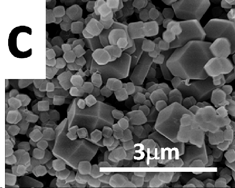Crossref Citations
This article has been cited by the following publications. This list is generated based on data provided by
Crossref.
Awadallah-F, Ahmed
Hillman, Febrian
Al-Muhtaseb, Shaheen A.
and
Jeong, Hae-Kwon
2019.
Adsorption Equilibrium and Kinetics of Nitrogen, Methane and Carbon Dioxide Gases onto ZIF-8, Cu10%/ZIF-8, and Cu30%/ZIF-8.
Industrial & Engineering Chemistry Research,
Vol. 58,
Issue. 16,
p.
6653.
Awadallah-F, Ahmed
Hillman, Febrian
Al-Muhtaseb, Shaheen A.
and
Jeong, Hae-Kwon
2019.
Adsorption of Carbon Dioxide, Methane, and Nitrogen Gases onto ZIF Compounds with Zinc, Cobalt, and Zinc/Cobalt Metal Centers.
Journal of Nanomaterials,
Vol. 2019,
Issue. ,
p.
1.
Tang, Pingping
Wang, Yaobin
and
He, Feiyu
2020.
Electrochemical sensor based on super-magnetic metal–organic framework@molecularly imprinted polymer for Sarcosine detection in urine.
Journal of Saudi Chemical Society,
Vol. 24,
Issue. 8,
p.
620.
Liang, Shan
Wu, Xiao-Ling
Xiong, Jun
Zong, Min-Hua
and
Lou, Wen-Yong
2020.
Metal-organic frameworks as novel matrices for efficient enzyme immobilization: An update review.
Coordination Chemistry Reviews,
Vol. 406,
Issue. ,
p.
213149.
Bergaoui, Manel
Khalfaoui, Mohamed
Awadallah-F, Ahmed
and
Al-Muhtaseb, Shaheen
2021.
A review of the features and applications of ZIF-8 and its derivatives for separating CO2 and isomers of C3- and C4- hydrocarbons.
Journal of Natural Gas Science and Engineering,
Vol. 96,
Issue. ,
p.
104289.
Xu, Yuandong
Sun, Lili
Sun, Yangang
Liu, Binyang
Guo, Hui
Wei, Yaqing
Feng, Haoyang
Wei, Yajun
and
Zhang, Xia
2022.
Effect of heat treatment on sensing performance of ZIF-67@GO for the detection of copper ions.
Colloids and Surfaces A: Physicochemical and Engineering Aspects,
Vol. 649,
Issue. ,
p.
129500.
Liu, Jing-Yi
Sheng, Mei-Si
Geng, Yu-Han
Zhang, Zi-Tong
Wang, Tian-Tian
Fei, Ling
Lacoste, Jed D.
Huo, Jian-Zhong
Zhang, Fei
and
Ding, Bin
2022.
In-situ encapsulation of oil soluble carbon nanoclusters in ZIF-8 and applied as bifunctional recyclable stable sensing material of nitrofurazone and lysine and fluorescent ink.
Journal of Molecular Structure,
Vol. 1269,
Issue. ,
p.
133766.
Issaka, Eliasu
Amu-Darko, Jesse Nii Okai
Adams, Mabruk
Yakubu, Salome
Gyimah, Eric
Ali, Nisar
Cui, Jiandong
and
Bilal, Muhammad
2023.
Zinc Imidazolate Metal–Organic Frameworks-8-Encapsulated Enzymes/Nanoenzymes for Biocatalytic and Biomedical Applications.
Catalysis Letters,
Vol. 153,
Issue. 7,
p.
2083.
Zhang, Mingyuan
Zhang, Xiangtai
Hu, Shuozhen
and
Zhang, Xinsheng
2023.
ZIF‐derived Low‐Cu‐loaded Carbon Catalysts for Oxygen Reduction Reaction.
ChemNanoMat,
Vol. 9,
Issue. 11,
Zhan, Ke
Chen, Linlin
Li, Shanshan
Yu, Qiuying
Zhao, Zheng
Li, Junwei
Xing, Yunrui
Ren, Hongtao
Wang, Na
and
Zhang, Gaiping
2024.
A novel metal–organic framework based electrochemical immunosensor for the rapid detection of Salmonella typhimurium detection in milk.
Food Chemistry,
Vol. 444,
Issue. ,
p.
138672.
Xiang, Yong
Yu, Daoyong
Qin, Changwei
Deng, Jiangyong
Wang, Xiaoqiang
Ge, Baosheng
and
Huang, Fang
2024.
Bimetallic zeolitic imidazolate frameworks Co/ZIF-8 crystals as carbonic anhydrase-mimicking nanozyme.
Colloids and Surfaces A: Physicochemical and Engineering Aspects,
Vol. 685,
Issue. ,
p.
133227.





